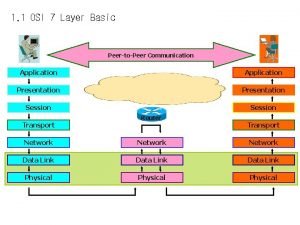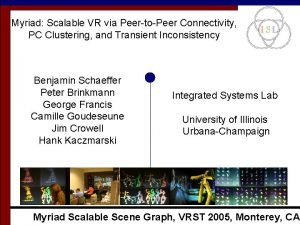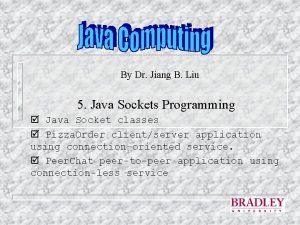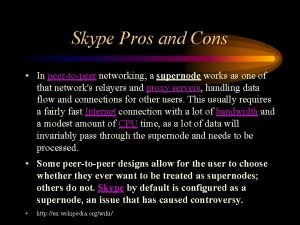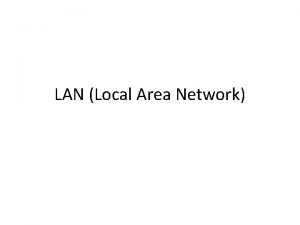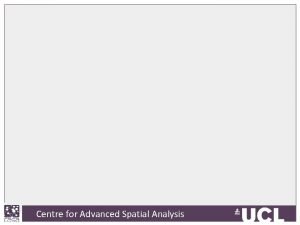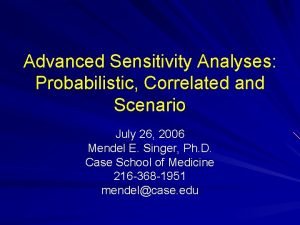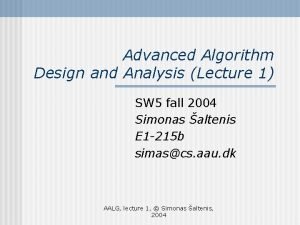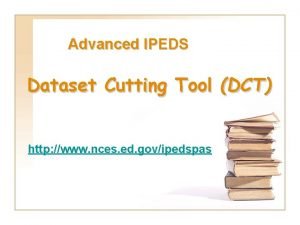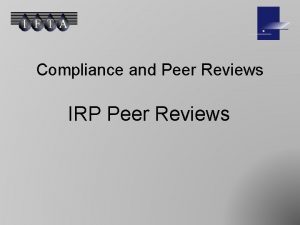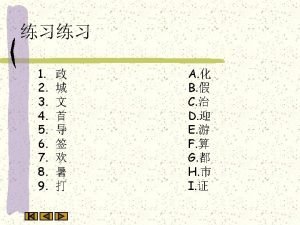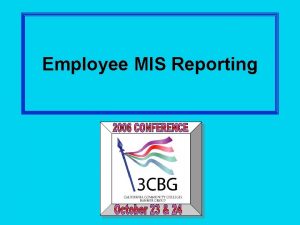IPEDS Peer Analysis System Advanced Module The place














































































- Slides: 78

IPEDS Peer Analysis System Advanced Module The place to go for IPEDS data: http: //nces. ed. gov/ipeds

Session Agenda ■ Data availability and issues ■ Important data concepts ■ Review of Peer Analysis System ─ Basics ─ Advanced features ■ Research Questions with PAS ─ Average freshman tuition discount ─ Expenditure comparison ─ Schools offering a specific degree

Data Available in the Peer Analysis System ■ 1980, 1984, 1985 HEGIS data ■ 1986 – 2004 IPEDS data ■ Selected HEGIS data not in the PAS are available at through the International Archive of Education Data housed at the University of Michigan.

Availability Caveats ■ Not all data are available for all years ■ New surveys have been added over time ■ Some data fields have been discontinued ■ New data fields have been added ■ Definitions may change

Data Availability by Year

Data Issues ■ Changes in finance reporting standards began in 1997 and have been phased in over a period of time. Now, most privates use FASB and most publics use GASB. However, there is still great variability in Finance data that makes inter-institutional comparisons problematic.

More Data Issues ■ Some data required in alternate years, but some schools submit for all years: ─ Enrollment by age: odd years ─ Residence of first-year students: even years ─ Fall staff: odd years Be very careful working with data from the years when submission is not required.

And More Data Issues… ■ Until submitting new variables is mandatory, not all schools submit data for them. ■ Continuing education is defined differently by different schools. ■ NCES began allowing schools to enter their own FTE values for 2002 -03 data year

Important Data Concepts 1. Collection year vs. data year 2. Imputation and perturbation 3. Release sequence of IPEDS data 4. Structure of IPEDS data files 5. Frequently used/derived variables

1. Collection Year vs. Data Year ■ Collection year: academic year in which the data are collected by NCES during the fall, winter, and spring collection cycle ■ Data year: academic year the data represent, which may be prior to the collection year

Status by Survey Component

Master Variables List Selection The surveys and the years for which data are available are displayed on the Master Variables List Selection screen.

2. Disclosure Protection ■ NCES is required by law to protect against disclosure of individually identifiable information collected in the IPEDS surveys ■ Impacts four IPEDS data files: ─Graduation Rates ─Student Financial Aid ─Salaries ─Fall Staff

Perturbation ■ Random alteration of data in cells with small number of observations ■ Protects the confidentiality of individually identifiable data ■ Occurs during migration of data from data collection system to the PAS ■ It’s unpopular—but the alternative is data suppression

Data Sharing ■ Data that an institution puts into IPEDS ─ ─ ─ ■ Data IN the IPEDS data collection system ─ ─ ─ ■ Belong to the institution May be shared BUT, may be subject to FERPA Technically belong to NCES Are subject to NCES confidentiality requirements May NOT be shared Data in the IPEDS Peer Analysis System ─ ─ ─ Have been perturbed Protect individually identifiable information May be shared

This pop-up window precedes any data access. You must agree to the terms in order to proceed with your analysis.

Imputation ■ IPEDS data are imputed for total nonresponse and item nonresponse ─ Various methods used such as prior year adjusted values, nearest neighbor, group means ■ Imputation allows files to be used for national totals ■ Imputed values appear on final data files ■ Web data input has dramatically reduced the need to impute data values

3. Data Release Stages ■ Pre-release: login at collection level ─ Data are reviewed and perturbed ─ Locked institutions are migrated to PAS ─ Data available for peer comparisons only ■ Early release: login at institution level ─ All institutions are migrated to PAS ─ Data available for peer comparisons only ■ Final release: login at guest level ─ Data are imputed and fully adjudicated ─ No restrictions on data use

4. Structure of IPEDS Data Files ■ Single-record files contain one line of data for each institution—for example, data in the Institutional Characteristics survey ■ Multiple-record files contain several lines of data for each institution—for example, data by race/ethnicity and gender in the Enrollment survey

Single-Record File

Multiple-Record File

Qualifying Variables ■ When choosing variables from multiplerecord files, the user must first specify the qualifying variables ■ The user’s choice tells PAS which records to select for the analysis

For example, in order to select Hispanic students, you must specify which Hispanic students. All Hispanic students? Full-time Hispanic students? Undergraduate Hispanic students? Level of student is the qualifying variable that lets you to choose. Here, choose Full-time students total and Part-time students total.

Then select Hispanic men and Hispanic women.

The resulting PAS file will contain a value for each possible combination:

5. Frequently Used/Derived Variables ■ Permanent “calculated variables ─ frequently used “institution” variables, e. g. , total enrollment, tuition and fees ─ data feedback report variables ─ College Affordability Index variables ■ Developed by NCES from existing IPEDS survey variables ■ Available beginning in 2002

The Peer Analysis System is the fastest way to capture IPEDS data for your analyses! Review of strategies

Analysis Strategy ■ Select a group of colleges and universities ■ Identify variables for years of interest and retrieve those data for the group of schools ■ Generate reports useful for policy analysis, peer comparisons, assessment, administrative decision-making, etc.

3 Steps to Peer Analysis: 1. Identify a Linch. Pin institution • the institution you want to compare with others 2. Construct a comparison group 3. Prepare your analysis • generate reports, files, statistics, graphs

Comparison Group ■ Three methods of construction ─ Select by name or Unit. ID ─ Select by variable (shared characteristics) ─ Auto peer group ■ Peer groups can be saved to your hard drive for later use as files with a ‘uid’ extension

Types of Analyses = Reports & Stats ■ Ranking report ─ One variable, with values sorted high to low ■ Institutions Data report ─ Multiple variables, perhaps from multiple files ■ Statistical Summary report ─ Basic descriptive statistics, with optional graphs ■ Report Templates ─ Prepackaged formats ■ Forms Facsimile ─ Survey data, presented in survey grid format

Master Variables List ■ Stores all variables used in a session ■ Accessible through Main Menu Session Summary ■ Lists can be saved to your hard drive with an. mvl extension

Calculated Variables ■ Three types: ─ Summation ─ Difference ─ Ratio ■ Can be built from IPEDS variables ■ Can be built from calculated variables ■ Can be saved to your hard drive as part of a Master Variables List

Support During Your Session ■ Session Summary ─ via Main Menu ■ On-line User Manual ─ can be printed ■ Help buttons ─ available on most pages ■ Info buttons ─ define variable characteristics

Log On to the Peer Analysis System http: //nces. ed. gov/ipeds

Select the Peer Analysis System

Login at the Institution level, which includes early release data with missing values not yet imputed.

1. Enter User ID (an IPEDS Unit. ID) 2. Enter Password (same Unit. ID) 3. Click the Login button You can use your institution’s Unit. ID or choose another. Find other Unit. IDs using IPEDS Cool.

You can use your own institution as Linch. Pin, or select another school that you want as the focus of your analysis

Session Summary identifies the Linch. Pin institution with no institutions in the comparison group and no variables in the Master Variables List. Click on Main Menu whenever you want to see a Session Summary or to access your Master Variables List.

Research Question ■ What is the average first-year tuition discount rate for private schools in California? Most private institutions allocate some of their own resources to fund scholarships to attract new students. In the aggregate, these scholarships reduce the institution’s average tuition.

Calculation Strategy Michael Duggan and Rebecca Matthews developed the following strategy: Freshman discount rate is the ratio of institutional grant aid to gross tuition revenue for the full-time first-time cohort.

Variables Required ■ For gross tuition revenue generated by new freshmen: ─ Tuition rate ─ Number of freshmen in cohort ■ For total institutional grant aid awarded to new freshmen: ─ Number of freshmen awarded institutional aid ─ Average amount of institutional aid awarded

IPEDS Survey Sources Constraint: The most recent financial aid data is 2003 -04, so all variables should be selected for this year.

Define Comparison Group ■ From Institutional Characteristics, 2003, add ─ State abbreviation ─ Sector of institution ■ To apply this exercise to public institutions, you would have to know the percentages of in-state and out-of-state students for each school.

Build Master Variables List ■ From Institutional Characteristics and Student Charges, 2003, add: ─ Published in-state tuition and fees 2003 -04 from Price of attendance of full-time, first-time undergraduate students (charges for full academic yr)

■ From Enrollments, 2003, from Total entering class: Fall 2003, add ─ Full-time first-time degree/certificate-seeking undergraduate (current years GRS cohort)

■ From Student Financial Aid, 2004, from Student counts and financial aid, academic year 2003 -04, from Financial Aid: Full-Time First-Time Degree/Certificate-Seeking Undergraduates, add ─ Number receiving institutional grant aid ─ Average amount of institutional grant aid received

Run Institutions Data Report ■ Select Reports and Stats, Institutions Data Report ■ From your Master Variables List, select all four variables ■ Specify long variable names ■ Download your results in csv format and save as an Excel file

…and it looks like this

Do Calculations in Excel ■ Total Tuition and Fees (tuition x number in freshman cohort) ■ Total Institutional Grant Aid (number receiving grant aid x average award) ■ Average Freshman Discount Rate (Institutional Grant Aid / Total Tuition & Fees)

Create an Attractive Report ■ Add a report title ■ Adjust column widths and column titles ■ Sort from high to low on average freshman discount rate

-Total Tuition Revenue -Total Grant Aid - Freshman Discount Rate Add a title, modify the headings, and format the numbers. It’s a report!

Research Questions ■ What percent of “core” expenditures (as defined by NCES) is represented by instruction? ■ Have these percentages changed between 2002 and 2004? Answer these questions for four-year public doctoral/research institutions in Georgia and Alabama.

Define Comparison Group ■ Add by Variable ■ From Institutional Characteristics, 2004, add ─ State abbreviation ─ Sector of institution ─ Carnegie Classification code

Query Form

Comparison Group

Add to Master Variables List ■ From Finance, 2004, from Frequently used financial indicators for all institutions: Fiscal year 2004, add ─ Core expenses, total dollar from Public institutions - GASB 34/35: Fiscal year 2004, add ─ Instruction - current year total

■ ‘Core expenses, total dollar’ must be calculated for 2002 and 2003. According to the info button for 2004, these are the components:

■ From Finance, 2002 and 2003, from Public institutions - GASB 34/35: Fiscal year 2002 and 2003, from Expenses and other deductions, add current year totals for those 11 variables:

Calculated Variables ■ Create two summation variables ─ Core Expenses 2003 ─ Core Expenses 2002 using the 11 components for each year ■ Create a ratio variable ─ Instruction as a Percent of Core, 2004 • Instruction – current year total as numerator • Core Expenses for 2004 as denominator

Recursive Calculated Variables ■ Create two ratio variables: ─ Instruction as a Percent of Core, 2003 ─ Instruction as a Percent of Core, 2002 using the same technique Why would you create a recursive variable instead of doing the calculation in Excel? So you can save it in a Multiple Variables List for use in the future!

Check to see if the columns are in chronological order, and fix them if they aren’t.

Create an Attractive Report ■ Add a report title ■ Adjust column widths and column titles ■ Order columns by year ■ Sort from high to low on ‘Instruction as a Percent of Core, 2002’ ■ Create a graph to illustrate changes over three years



Research Questions ■ How many schools offer doctorates in Exercise Science? ■ How many doctorates in Exercise Science do they award? The Enrollment survey does not collect data by program, but Completions contains degrees awarded. Look at degrees awarded over a three-year period because not all schools with the program may award degrees every year.

Build Master Variables List From 2003, 2004, 2005 Completions: ■ Qualifying variables: ─ CIP Code: 31. 0505, Kinesiology and Exercise Science ─ Award Level: Doctor’s degree ─ First or Second major: First major ■ Variable: ─ Grand total

Comparison Group Strategy Because Exercise Science is a relatively small degree-producing program, you want to include in your sample all schools that awarded doctorates during a three-year period. That is, you want all schools that awarded doctorate in 2002 -03 OR in 200304 OR in 2004 -05, not just those that awarded doctorates in all three years—or only in 2004 -05.

Define Comparison Group From Master Variables List: ■ Select only Exercise Sci doctorates, 2002 -03 ─ Go to the query form; ─ Specify all schools with >0 degrees ─ 28 schools in comparison group ─ Accept and Continue ─ Add by Variable (from the Master Variables List)

■ Select only Exercise Sci doctorates, 2003 -04 ─ Go to the query form; ─ Specify all schools with >0 degrees ─ 28 schools in comparison group ─ Combine the two sets and eliminate duplicates ─ 31 schools in comparison group ─ Add by Variable (from the Master Variables List)

■ Select only Exercise Sci doctorates, 2004 -05 ─ Go to the query form; ─ Specify all schools with >0 degrees ─ 29 schools in comparison group ─ Combine the two sets and eliminate duplicates ─ 34 schools in comparison group ─ Examine the final list

Your sample contains 34 schools that awarded one or more doctorates in Exercise Science during one or more of the three years.

Run Institutions Data Report ■ Select Reports and Stats, Institutions Data Report ■ From your Master Variables List, select all three years of Completions data ■ Specify long variable names ■ Download your results in csv format and save as an Excel file

Your raw data file should look like this. Note that some schools did not award doctorates each year.

Create an Attractive Report ■ Add a report title ■ Adjust column widths and column titles ■ Create a column for 3 -year total ■ Sort from high to low on total degrees ■ Sum total degrees produced each year

You can print these results and distribute them!

Questions? Comments? Feedback?
 Bitcoin: a peer-to-peer electronic cash system
Bitcoin: a peer-to-peer electronic cash system Annotazioni sulla verifica effettuata peer to peer
Annotazioni sulla verifica effettuata peer to peer Peer-to-peer
Peer-to-peer Tim beamer
Tim beamer Peer to peer transactional replication
Peer to peer transactional replication Gambar topologi peer to peer
Gambar topologi peer to peer Esempio registro peer to peer compilato
Esempio registro peer to peer compilato Esempi di peer to peer compilati 2021
Esempi di peer to peer compilati 2021 Relazione finale tutor tirocinio esempio
Relazione finale tutor tirocinio esempio Peer to peer l
Peer to peer l Peer to peer merupakan jenis jaringan… *
Peer to peer merupakan jenis jaringan… * Features of peer to peer network and client server network
Features of peer to peer network and client server network Programmazione e sviluppo condiviso compilato
Programmazione e sviluppo condiviso compilato Peer-to-peer communication in osi model
Peer-to-peer communication in osi model Peer p
Peer p Addresss look up
Addresss look up Peer-to-peer o que é
Peer-to-peer o que é Peer to peer computing environment
Peer to peer computing environment Peer to peer intervention
Peer to peer intervention Peer-to-peer o que é
Peer-to-peer o que é Peer-to-peer o que é
Peer-to-peer o que é Peer to peer network hardware
Peer to peer network hardware Peer to peer chat application in java
Peer to peer chat application in java Skype reviews pros and cons
Skype reviews pros and cons Jaringan peer to peer diistilahkan dengan
Jaringan peer to peer diistilahkan dengan Examples of preposition of place
Examples of preposition of place C device module module 1
C device module module 1 Millions billions trillions chart
Millions billions trillions chart A repeating disturbance that transfers energy
A repeating disturbance that transfers energy A disturbance that transfers energy from place to place
A disturbance that transfers energy from place to place Good morning children
Good morning children Hình ảnh bộ gõ cơ thể búng tay
Hình ảnh bộ gõ cơ thể búng tay Frameset trong html5
Frameset trong html5 Bổ thể
Bổ thể Tỉ lệ cơ thể trẻ em
Tỉ lệ cơ thể trẻ em Voi kéo gỗ như thế nào
Voi kéo gỗ như thế nào Tư thế worm breton là gì
Tư thế worm breton là gì Chúa sống lại
Chúa sống lại Các môn thể thao bắt đầu bằng tiếng đua
Các môn thể thao bắt đầu bằng tiếng đua Thế nào là hệ số cao nhất
Thế nào là hệ số cao nhất Các châu lục và đại dương trên thế giới
Các châu lục và đại dương trên thế giới Cong thức tính động năng
Cong thức tính động năng Trời xanh đây là của chúng ta thể thơ
Trời xanh đây là của chúng ta thể thơ Mật thư tọa độ 5x5
Mật thư tọa độ 5x5 101012 bằng
101012 bằng Phản ứng thế ankan
Phản ứng thế ankan Các châu lục và đại dương trên thế giới
Các châu lục và đại dương trên thế giới Thơ thất ngôn tứ tuyệt đường luật
Thơ thất ngôn tứ tuyệt đường luật Quá trình desamine hóa có thể tạo ra
Quá trình desamine hóa có thể tạo ra Một số thể thơ truyền thống
Một số thể thơ truyền thống Cái miệng nó xinh thế chỉ nói điều hay thôi
Cái miệng nó xinh thế chỉ nói điều hay thôi Vẽ hình chiếu vuông góc của vật thể sau
Vẽ hình chiếu vuông góc của vật thể sau Thế nào là sự mỏi cơ
Thế nào là sự mỏi cơ đặc điểm cơ thể của người tối cổ
đặc điểm cơ thể của người tối cổ V cc
V cc Vẽ hình chiếu đứng bằng cạnh của vật thể
Vẽ hình chiếu đứng bằng cạnh của vật thể Fecboak
Fecboak Thẻ vin
Thẻ vin đại từ thay thế
đại từ thay thế điện thế nghỉ
điện thế nghỉ Tư thế ngồi viết
Tư thế ngồi viết Diễn thế sinh thái là
Diễn thế sinh thái là Các loại đột biến cấu trúc nhiễm sắc thể
Các loại đột biến cấu trúc nhiễm sắc thể Bảng số nguyên tố lớn hơn 1000
Bảng số nguyên tố lớn hơn 1000 Tư thế ngồi viết
Tư thế ngồi viết Lời thề hippocrates
Lời thề hippocrates Thiếu nhi thế giới liên hoan
Thiếu nhi thế giới liên hoan ưu thế lai là gì
ưu thế lai là gì Sự nuôi và dạy con của hổ
Sự nuôi và dạy con của hổ Sự nuôi và dạy con của hươu
Sự nuôi và dạy con của hươu Sơ đồ cơ thể người
Sơ đồ cơ thể người Từ ngữ thể hiện lòng nhân hậu
Từ ngữ thể hiện lòng nhân hậu Thế nào là mạng điện lắp đặt kiểu nổi
Thế nào là mạng điện lắp đặt kiểu nổi Advanced higher art understanding standards
Advanced higher art understanding standards Advanced topics in software analysis and testing
Advanced topics in software analysis and testing Memory forensics training
Memory forensics training Centre for advanced spatial analysis
Centre for advanced spatial analysis Advanced sensitivity analysis
Advanced sensitivity analysis Advanced algorithm design
Advanced algorithm design













